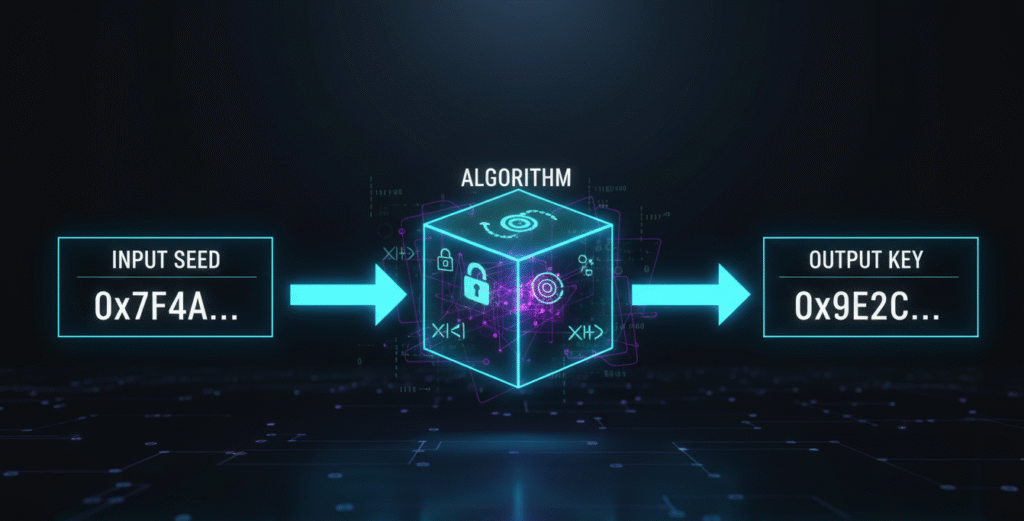
Seed-to-key Algorithms are a recurring challenge in automotive security, diagnostics and aftermarket tool development. When an OEM or workshop needs an interoperable diagnostic routine, or a retained technical capability to reproduce authentication flows, recovering a seed to key function from ECU firmware and supporting artifacts is often required.
This article explains a proven, repeatable methodology for reconstructing seed to key logic from embedded firmware, CAN logs and available reference code. It is written to inform engineers who need to understand the technical path as well as technical decision-makers who must evaluate a trusted provider. The article also explains what to expect when engaging a specialised reverse engineering team for this work.
Seed-to-Key Algorithms Technical Overview & Why it matters

In many ECUs the authentication flow is implemented as a deterministic mathematical transformation: the diagnostic tool sends a seed (random challenge), the ECU computes a key from that seed and returns it, and the tool uses the key to unlock privileged commands. The transformation may be simple arithmetic, multi-precision arithmetic, custom S-boxes or true cryptography, and crucially, it is often implemented with application-specific helper routines rather than a standard crypto library. Recovering the forward algorithm (Seed-to-key) enables tool developers to build compliant diagnostic software, validate security controls, and perform legitimate service operations. It also supports security research and authorized vulnerability analysis.
Our process follows three concurrent threads:
- (1) static firmware analysis to locate candidate routines and tables,
- (2) artifact reconciliation using any available reference code and unit tests,
- (3) protocol/log analysis to validate assumptions and produce test vectors.
These threads converge into an implementation and verification stage that produces a clean C implementation of the forward (Seed-to-key) function and, where feasible, the inverse (key-to-seed) or practical alternatives (search tools, SMT/meet-in-the-middle helpers).
Files and inputs that accelerate success

The single most helpful combination of inputs is: a firmware dump (ECU binary), captured protocol logs showing Seed-to-key exchanges (CAN logs or diagnostic traces), and any reference implementation (even partial, e.g., a vendor sample, unit tests or a helper script). With those three inputs you can: map constants/tables from the reference implementation to the firmware binary, extract structural matches (loops, table sizes), and verify results against real world logs.
Detailed methodology Seed-to-key pairs
First pass, harvest and triage. We extract readable strings and constant arrays from the firmware and any reference code. We run quick heuristics to find characteristic patterns: repeated numeric constants (loop bounds like 0x3F), bit/word sizes (e.g., 32-bit words), and helper routine names (multiply/shift/mix). If a reference project contains unit tests that produce seed/key pairs, we generate those vectors and treat them as canonical golden vectors.
Static binary analysis: Using disassembly and decompilation (Ghidra/IDA), we search the firmware for functions that reference candidate constants or tables found in the reference implementation. We look for: loops that iterate a fixed number of times, multi-precision multiply/shift sequences, table lookups (S-boxes), and bit packing/unpacking consistent with the reference code. Matches are verified by extracting local constants and comparing them to reference values; even short subsequences of an array are powerful anchors for locating code in a stripped binary.
Protocol/log analysis: CAN or diagnostic logs are parsed to identify the exact seed-to-key exchanges (frame IDs, byte offsets, endianness). We extract seed/key test vectors and use them to validate candidate code paths. Where the firmware contains runtime constants computed from the seed, the logs help confirm that we found the correct function.
Algorithm reconstruction: From the reference code (if available) and the decompiled firmware, we build a step by step pseudo code description of the forward transform. If the function uses invertible linear/affine blocks (rotates, XORs, modular adds, multiplications with invertible constants) we attempt algebraic inversion. If the forward function uses irreversible mixing or large non-invertible elements, we evaluate practical inversion strategies: segmented brute force, meet-in-the-middle across splitting points, and SMT/SAT encodings for small domains. If those are infeasible, we propose dynamic or hardware approaches (live captures, debug port access).
Representative code insight, Clean C prototype (forward function)
Below is a concise and realistic C skeleton for a forward seed-to-key function. It reflects the kinds of operations we commonly see, packing the seed into words, word-level multiply/shift/mix operations, looped accumulation into working state, and final folding into key bytes. This is a working skeleton to be completed with real constants and helper semantics extracted from the reference code and firmware.
#include <stdint.h>
#include <stdlib.h>
#include <string.h>
#define WORD_BITS 32U
#define WORD_MASK 0xFFFFFFFFU
#define ITERATIONS 0x3F // example: common loop bound observed
#define OFFSET 0x7DF // example offset constant (source-dependent)
// Example tables to be filled from reference/source
static const uint32_t TABLE_MULT[] = { /* fill from reference */ };
static const uint32_t TABLE_SHIFT[] = { /* fill from reference */ };
static const uint32_t TABLE_XOR[] = { /* fill from reference */ };
static inline uint32_t mul32(uint32_t a, uint32_t b) {
uint64_t r = (uint64_t)a * (uint64_t)b;
return (uint32_t)(r & WORD_MASK);
}
static inline uint32_t rotl32(uint32_t v, unsigned s) {
s &= 31;
return (v << s) | (v >> (32 - s));
}
void parse_seed(const uint8_t *seed, size_t seed_len, uint32_t *out_words, size_t wlen) {
for (size_t i = 0; i < wlen; ++i) {
uint32_t w = 0;
for (size_t b = 0; b < 4 && (i*4 + b) < seed_len; ++b)
w |= ((uint32_t)seed[i*4 + b]) << (8*b); // little-endian
out_words[i] = w;
}
}
int forward_seed_to_key(const uint8_t *seed, size_t seed_len, uint8_t *key_out, size_t key_len) {
size_t wlen = (seed_len + 3) / 4;
uint32_t *words = calloc(wlen, sizeof(uint32_t));
if (!words) return -1;
parse_seed(seed, seed_len, words, wlen);
uint32_t *state = calloc(ITERATIONS + 1, sizeof(uint32_t));
if (!state) { free(words); return -2; }
// Example mixing loop (fill with real ops from reference)
for (size_t i = 0; i <= ITERATIONS; ++i) {
uint32_t tmp = mul32(words[i % wlen], TABLE_MULT[i % (sizeof(TABLE_MULT)/4)]);
tmp = rotl32(tmp, TABLE_SHIFT[i % (sizeof(TABLE_SHIFT)/4)]);
tmp ^= words[(i + 1) % wlen] ^ TABLE_XOR[i % (sizeof(TABLE_XOR)/4)];
tmp = (tmp + OFFSET) & WORD_MASK;
state[i] = tmp;
}
// Collapse state into key bytes (simple example)
for (size_t i = 0; i < key_len; ++i)
key_out[i] = (uint8_t)((state[i % (ITERATIONS+1)] >> ((i % 4)*8)) & 0xFF);
free(words);
free(state);
return 0;
}
This snippet is intentionally generic: the exact table contents, helper semantics and endianness must be taken from the firmware and any available reference sources. That said, the structure above is exactly the pattern we usually see when reconstructing Seed-to-key math: parse → iterate/mix → fold.
Challenges & practical mitigations
Proprietary or obfuscated code, stripped symbols and custom multi-precision helpers make discovery harder, but not impossible. Common obstacles and mitigations include:
- Obfuscated tables or packed constants: use subsequence matching and cross-reference constant patterns between reference code and firmware. Even a short unique subarray match in the binary reliably narrows candidate functions.
- Non-standard multi-precision arithmetic: port helper routines found in firmware (e.g., custom
crymultorcryshift) into a high-level language and unit test them with known vectors. - Non-invertible mixing: apply hybrid techniques, derive partial inverses, then search smaller domains per segment (meet-in-the-middle) or use SMT encodings for restricted search spaces.
- Live verification: when static techniques stall, instrumented ECU captures or test benches can provide additional Seed-to-key pairs under controlled conditions.
Outcome & verification
A robust deliverable set for this work includes: a documented C source file implementing the Seed-to-key forward function, a test harness that reproduces the known Seed-to-key pairs, a mapping document showing firmware offsets and evidence of matching constants/tables, and a validation report with test vectors taken from raw CAN/diagnostic logs. Where possible and contractually allowed, the inverse function (key-to-seed) or practical search tools are delivered; if algebraic inversion is infeasible, we deliver deterministic tools (search helpers and SMT scripts) that produce seed candidates given a key within well defined computational bounds.
Engaging a provider: what to expect and how to prepare
To accelerate delivery, prepare and share:
- (1) the firmware dump (full ECU image),
- (2) protocol logs showing seed and key exchanges (CAN logs, diagnostic logs), and
- (3) any existing reference code or unit tests (even partial).
Also confirm the legal and access context in writing (proof of authorization). Typical engagements are structured in milestones: an initial discovery and mapping milestone (extract constants, verify matches, deliver forward function), followed by a second milestone for inversion or search tooling. A transparent milestone plan benefits both parties and reduces risk.
This type of work requires technical depth and strict confidentiality. A trusted provider will sign an NDA, handle artifacts securely, and only proceed with written authorization. Providers experienced in ECU Reverse Engineering will combine firmware analysis, protocol parsing, and pragmatic engineering to deliver testable, maintainable C code suitable for integration into diagnostic stacks or research frameworks.

Seed-to-key recovery is a solvable engineering problem when approached with the right inputs and an experienced methodology: classification, static firmware mapping, reference reconciliation, algorithm restructuring, and rigorous verification. Whether you need a deterministic C implementation of advanced Seed-to-key transformation, proof-of-conformance matching, or practical reversal tools, Reverseengineer.net’s expert reverse engineering team delivers reliable and auditable results. If you’d like a concise quote tailored to your ECU model and builds (firmware dump, logs, reference tests), contact us and include the three elements listed above; this will provide a high-confidence cost and schedule estimate.
Q1. What is a seed-to-key algorithm?
A mathematical transformation used in automotive ECUs where the ECU issues a seed, and the diagnostic tool must compute a key for access.
Q2. How long does ECU reverse engineering take?
Typical projects take 1–2 weeks, depending on algorithm complexity and available test data.
Q3. What do I need to provide?
Firmware dump, CAN logs showing seed/key exchanges, and any reference code or test vectors. These three inputs accelerate the process significantly.
Let's Work Together
Need Professional Assistance with Reverse Engineering or Cybersecurity Solutions? Our Team is Ready To Help You Tackle Complex Technical Challenges.